Steep Trail Running: Tips For Handling The Terrain
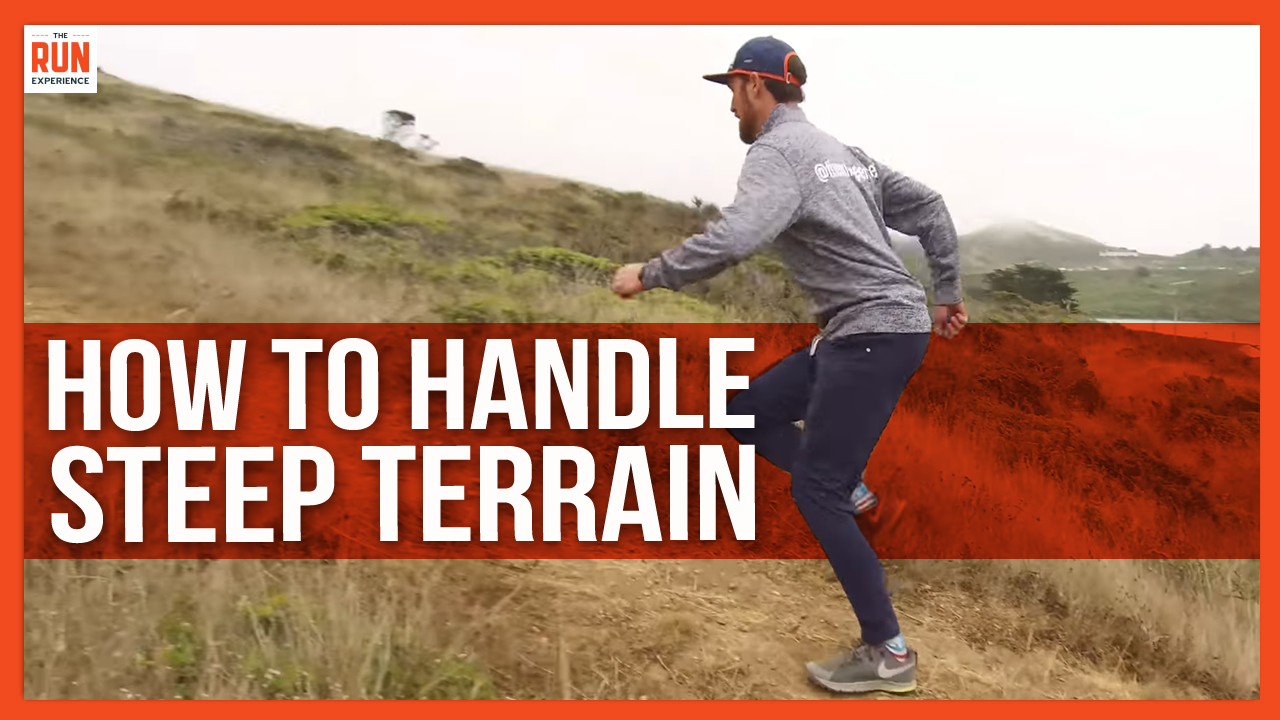
Whether you spend your time running the roads or the trails, you’re likely to run into some big enough inclines that you’ll need to change up your technique at least a bit. Steep trail running, in particular, requires some thought, practice, and knowledge in order to make informed decisions.
We want to help you avoid face-planting while cruising downhill or totally burning out while grinding uphill. How does the hill itself change your stride? What if your footing is loose? We’ll answer these questions and more to get you ascending and descending quickly and safely.
Not All Hills Are Created Equal
Before we dive into strategies for steep trail running, it’s important to figure out which type of hill you are running. For a longer trail race or run, not all of the hills are going to be runnable.
You may be physically able to run the tough hill, but on a long course, you will pay for it later on in the run. Depending on the grade (incline) and length of the hill, you might be better served by strategies other than just grinding it out until you get to the top!
The Runnable Hill
The first hill is the runnable hill. It’s not too long, and while it might be tough to do so, we can run up it.
For the runnable hill, keep your stride short and compact. Maintain a steady pace as you work your way up.
Avoid over-exerting on this hill. Keep a steady pace and a short stride to preserve energy. Beginner runners or those newer to climbing hills, don’t be afraid to take walk breaks! We’ll go into a bit more detail about breaking up the run in the next section, but it applies here, as well.
Even if the hill might be runnable for some, others might need to build in some walk breaks here as well. Just make sure to stride with purpose, and use your arm swing to help propel you forward.
The Partially Runnable Hill
Depending on how far into the run you are and how steep the hill is, you may need to combine running and hiking. As mentioned above, throwing in some walking (or power hiking, as commonly referred to in the trail running world), can help you get up the hill without totally gassing yourself.
Run a few steps, and then hike a few steps, and steadily alternate until you reach the top.
A good starting divide is running 20 steps and then hiking 20 steps. Alternatively, you can use rocks, trees, light posts, or other built-in landmarks to help you break up the hill. I like to call this the “run to that tree” game.
By using the landmarks you can avoid the trap of stopping at 15 steps of running because “that’s good enough.” The tree you pre-selected won’t get any closer if you slow down, so you’re better off continuing running until you get there!
On the other hand, some runners like the zen-like state they can get into by repeatedly counting to a set number, in this case, 20, so play with both strategies and see what works for you.
Hikers-Only Hill
The last type of hill is simply too steep to run, whether it’s at the start of your course or in the middle of a longer one. For this type of uphill effort, just hike it.
While it may feel weird to walk during a race if you are racing, your body will thank you in the long run for recognizing the need to walk.
For one thing, you’ll avoid spiking your heart rate too high too quickly. Getting your heart pounding will send your body out of endurance mode and into anaerobic, panic mode. Not good when you’re on a long training run or you’re halfway through your 50k race!
For another, when you switch from running to walking, you’re recruiting some different muscles and type of mobility to still be moving forward. Your calves get some rest and your glutes get to take over more the work. Your hip flexors can get a bigger stretch with each stride and your ankles will flex more to accommodate the incline.
This type of change will help you avoid totally exhausting any particular muscle group or movement pattern, thus helping preserve your endurance for the rest of the run.
Common Mistakes While Tackling Steep Trail
Foot Position
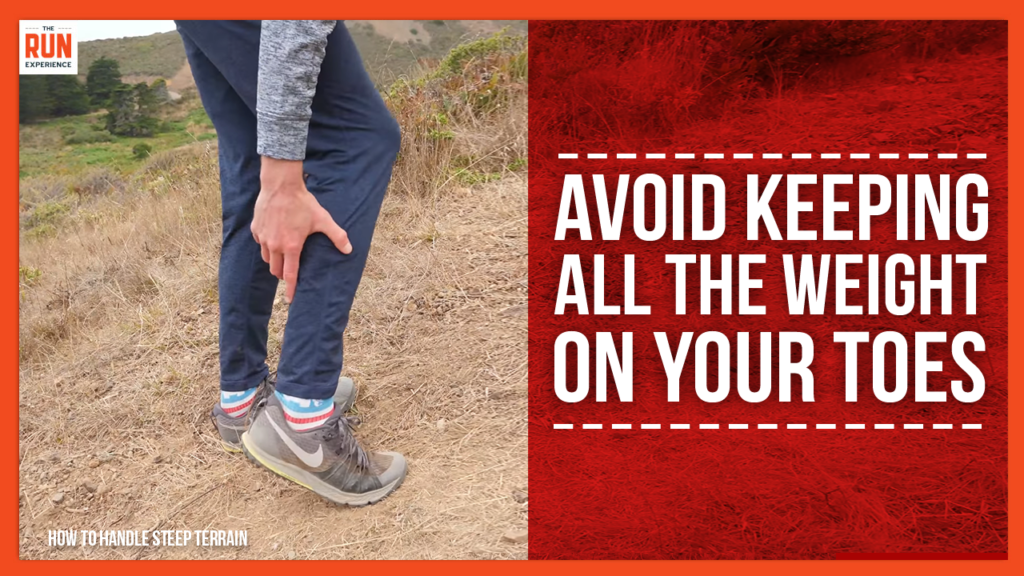
The first common mistake runners can make while tackling a steep trail is to keep the weight on the toes. While it may feel more powerful to attack the hill on your toes, you need to save your calves for the rest of the run.
Though the calves have some good power in them to propel you upward, they won’t take the uphill punishment forever. If you keep constant tension on them while moving up the incline, eventually they’ll rebel and cramp up on you.
In order to avoid burning out those calves, your heels need to briefly touch the ground with each stride. Think of it as a quick kiss to the trail, rather than firmly settling your heel down each time. This may feel more difficult than usual because running uphill requires more dorsal flexion in the foot.
To accommodate this, hinge forward slightly at your hips. This way your heels can touch the ground more easily. Be sure to keep your core tight to avoid throwing off your posture here. No slumping forward!
The Run/Walk Divide
The next two mistakes fall into the same category: choosing when to run and when to walk.
The first common mistake here is to run too long. It can be a tough thing to allow yourself to walk, especially if it’s early in the trail race. You might be caught up in the field of runners and not want to be the one to drop down to a hiking pace.
However, if your heart rate spikes too high, it is going to take too long to recover from that feeling, and by the middle or end of your race, you’ll be totally gassed.
If you’re on a training run, it might sound like a good idea to just attack the hill. After all, the more you run, the faster you’re done, right? And your Strava segment will know you slowed down! Now, now, don’t get caught up in the numbers.
Any time you save by running hard early on can easily–and most likely will–be lost later in your run when the jelly legs set in and you have to walk a section that would otherwise have been runnable. Trust me, I’ve been there!
The second common mistake is to let yourself walk for too long. Be tough on yourself here. This walk break isn’t a mosey or a rest. It’s a strategic break to keep moving forward while allowing your body to recover or to get across terrain that you can’t safely run.
Walk only when you know you need to, and start running as soon as you can after that. You can always return to walking if you got going too soon, but the goal should always be to get back to running as soon as possible.
Don’t Forget the Steep Trail Down
Descending a steep trail requires the same type of strategizing as when climbing. From pacing to cadence to positioning, there’s a lot to think about to safely get down those steep trails.
First off, remember that the downhill is not your rest period. This isn’t the time to slow down and recoup your energy, even in that sounds counterintuitive. The flat portions of your course are better for that, as you don’t have to employ many strategies on those sections.
Going downhill on a steep trail requires focus as you’re going to encounter loose rocks, tree roots, and other obstacles that can be dangerous on the downhill.
Also, from a competitive standpoint–the downhills are often what separate the top finishers.
Just like when going uphill, figure out what type of downhill you’re on. Is there loose gravel to look out for? How steep is the hill? Is it so steep that you need to hike down in order to be safe?
Make those decisions at the beginning of your descent so that you know what you’re up against.
Use Your Eyes
This seems like an obvious downhill tip, but look ahead! Try to focus on what lies ahead so that you can adequately prepare for it. Just like when you’re driving a car, you’re not looking directly in front of you. Instead, you’re scanning the road ahead of you to watch out for traffic coming into your lane or a piece of litter about to blow in front of you.
Alternate looking at the terrain you are currently running over and what’s up next, and keep switching back and forth to ensure you’re ready what’s to come.
With this strategy, you’re less likely to catch your toe on a root or to not see the upcoming section of loose gravel that’ll send you for a spin.
Keep Your Cadence High
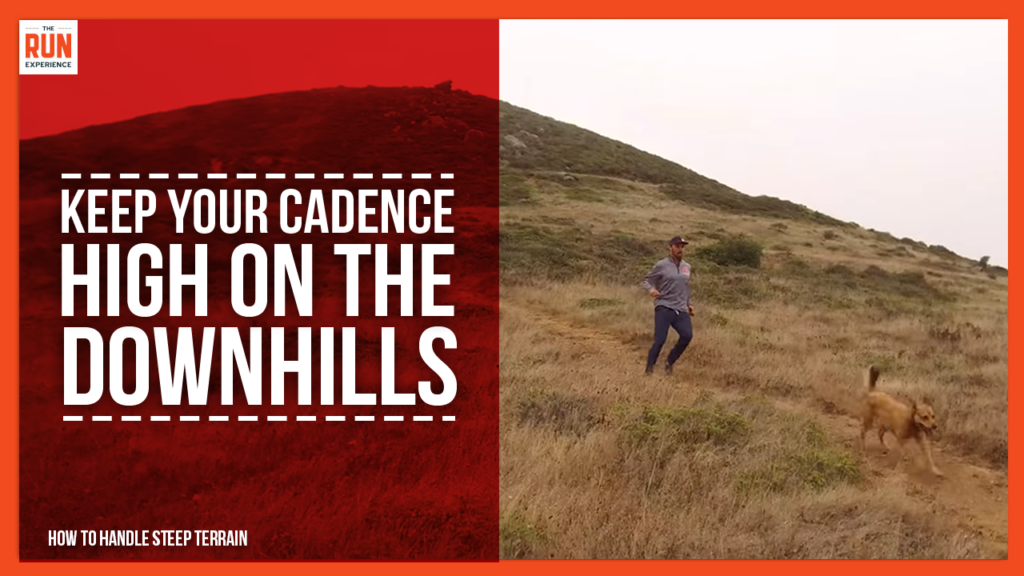
It can be tempting going downhill to take an easy pace. For most downhills, this is doing you a disservice.
First, it’s putting a lot of pressure on your quads, a muscle group you will desperately need on the next uphill portion of the race. Instead of taking slow, heavy steps to plod your way down, think about “fast feet.”
Keep your impact with the trail light and quick to minimize your time on the ground. This type of quick-stepping will help reduce the beating your legs take as well as keeping your cadence higher and lighter.
In addition, keeping a high cadence reduces the likelihood of stumbling. By picking your feet up and turning them over more quickly, you are less likely to drag your feet behind you and accidentally trip on something (speaking from experience!)
Keep Your Center of Gravity Forward
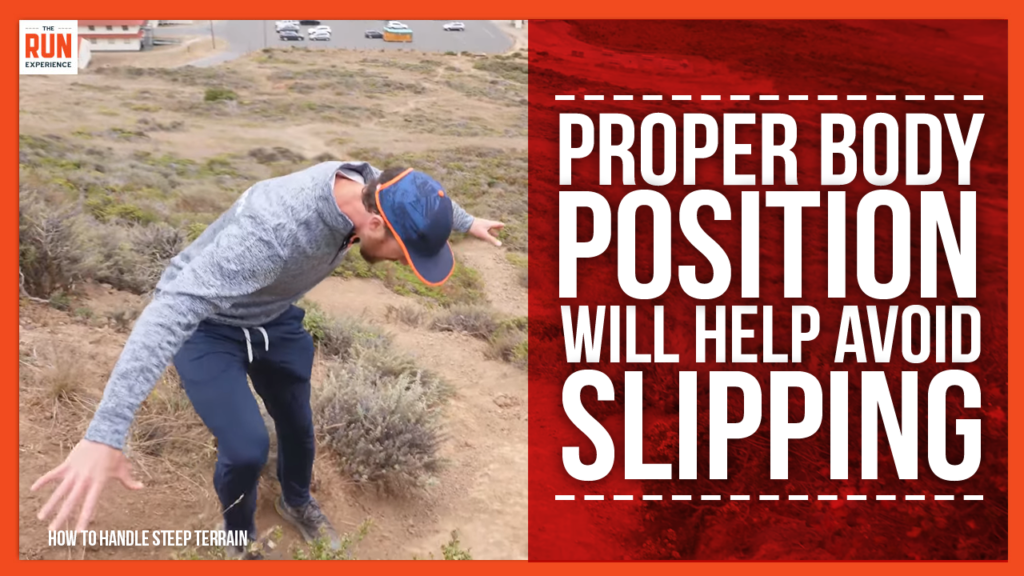
Our bodies’ natural tendency when going downhill is to lean back like we’re putting on the breaks. This actually increases the likelihood that we will slip.
With less weight directly over our feet, they are more likely to slip out from under us as we’re moving. By staying upright or slightly leaning forward, you keep more of your weight centered over your feet, which increases your stability.
Practice Your Downhill
It’s important not to descend beyond your ability. This means that while the tips above are certainly going to improve your downhill running, you don’t want the first time you try them to be on race day.
Start practicing descending in your training, just as you practice running uphill. For downhill repeats, try to descend quickly and lightly, employing the strategies mentioned above. When you’re climbing back up to the top of the hill to descend again, take it easy.
You don’t need to push the effort on the uphill as well as the downhill, so use the trip back up as your recovery.
If you can, practice the specific downhills you will be running on race day many times beforehand. The more familiar you are with the hills, the higher you can safely keep your cadence, and the less afraid you will be to keep your body weight forward.
Practicing downhills is the only way to ensure your safety come race day.
Get Some Gear For The Steep Trail Terrain
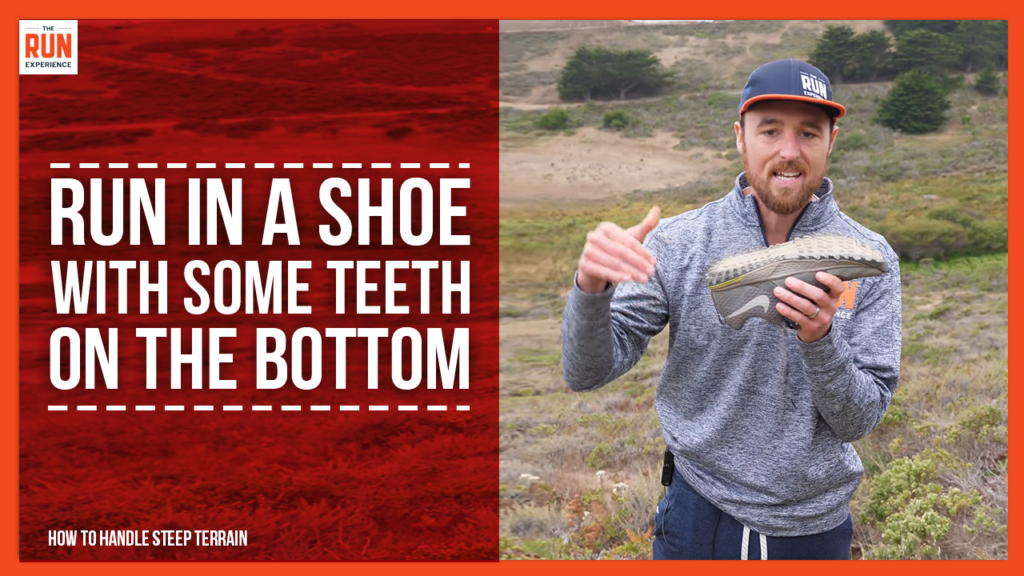
On a steep trail with loose gravel, tree roots, and other obstacles, you’ll be wise to invest in a trail running shoe with some teeth on the bottom. Your road shoes just won’t cut it here and could make you think steep trails are tougher efforts than they need to be.
It is important that your shoe can hold onto the trail. Depending on what you’ll be encountering–mud, gravel, wet rocks, sand, etc. It will affect what type of trail shoe you use. Different shoes are better for different terrain, so just as with your other gear or nutrition, some experimentation might be necessary.
Also, keep the time of year in mind. A trail might be less slippery if it’s been raining a bit because the moisture helps pack together with the dirt and gravel.
Dry trails are often more slippery because things are free to move around. However, if it’s so wet that the dirt has turned into slippery mud, it may be even worse.
The fix here, as stated above, is to practice. Practice your uphills and downhills in different weather conditions so that you are prepared for anything on race day.
The more you practice, the more educated your decisions will be about when to run, walk, speed up, and slow down.
This will also help you avoid injuries. Check out this article on what can you do to prevent running injuries for more tips on that.
With that said, happy trail running!
